Don loves personal computers. He has loved them ever since he sat down at his first, back in 1983. He loves the convenience of the little beasts, he loves word-processing and email, and he even loves their minor quirks (sometimes).
Don't look here for holy wars or emotional tirades. Don is not one of those computer users who feels that he must demonstrate the superiority of his own choice by tearing down your choice. (Yes, this means you and you and particularly you.)
Great-grandpappy Kipling said:
"There are nine and fifty ways of composing tribal lays
And every single one of them is right."
Words that should be written in gold above the monitor of every Holy Warrior in the endless operating-system conflicts of our day.
So, please: if you're looking for someone who will join you in attacking other platforms -- or someone who will help you to congratulate yourself for picking the One True Faith -- please go elsewhere. OTOH, if you want a quick trip down memory lane, with fond remembrance of the machines and operating systems touched along the way -- then, by all means, stay.
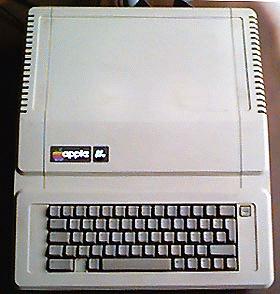 |
Granny Smith (vintage 1983)The first pc Don ever used was a venerable Apple IIe, with monochrome (green) monitor, 32K of RAM, and two floppy drives. Granny Smith, a splendid example of the breed, is currently enjoying her retirement in the computer museum on the Third Floor. |
Alan Turing (1984)The first pc Don owned was Alan Turing, a Commodore C-64 with 64K of RAM, one disk drive, and a portable color TV for a monitor. You may laugh, but Don wrote three books on Alan. Alan Turing is now enjoying a comfortable retirement on the Third Floor. |
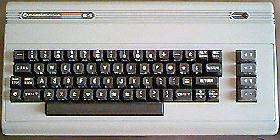 |
 |
Christopher Morcom (1985)Named for Alan Turing's boyhood chum, Christopher was a Tandy Model 100, the first true laptop and a legendary machine. Into his 32K of RAM, Christopher packed more utility than any five other computers. Christopher travelled with Don to England, all over the U.S., and to the library just about every day. He gave nearly ten years of faithful service before being retired. Because it seems so fitting, we are investigating ways to mount Christopher in Thomas's VW Van. |
The Giant Space Amiga (1988)An Amiga 2000 with a 68030 processor, 9 MB of memory, and various hard drives. For a long while, the Giant Space Amiga was everything: writing machine, telecommunications machine, file archive, and general information appliance. With onboard 8088 Bridgeboard, the Giant Space Amiga had another personality: Epimetheus, an IBM PC clone. The GSA is host to a Video Toaster and DPS Personal Animation Recorder, and is the video workhorse for Speed-of-C Productions. |
 |
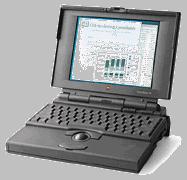 |
Mac-El (1995)When Christopher could no longer cut it, we acquired an Apple Powerbook 150 named Mac-El (of the Krypton Els). Mac-El boasted a 68030 chip, 12 MB of memory, and an onboard 28,000 bps faxmodem. Mac-El, too, accompanied Don everywhere (including, so far, one trip to Scotland/England). Mac-El became the primary writing machine, while The Giant Space Amiga served all other functions. |
Reptar (1995)Thomas purchased a second-hand Amiga 2000, which we promptly named Reptar. With a 68000 chip and 4 MB of RAM, Reptar was more than up to the challenge of telecommunications (primarily email) in the text-based days before the Web. Reptar is currently in the organ banks, as a donor for the Giant Space Amiga. |
 |
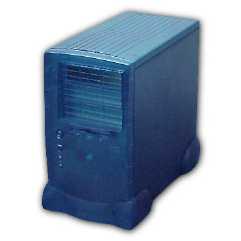 |
Orac (1996)Don rose to the challenge and built Orac, an MS-DOS/Windows95 box thrown together from parts obtained at computer shows. When Don screws things up royally by overreaching his knowledge, Thomas takes Orac to our friend Paul Moscat, who fixes him up. We try to update Orac every couple of years. Currently, Orac has a 233 MHz Cyrix K6-II processor, 32 MB of RAM, and a 6 GB hard drive. Orac is our primary telecommunications machine, which includes Web browsing. He also serves the business needs of the Star Toys Museum. Via ethernet connection, Orac is connected to the Meerkat Meade LAN. Orac's snazzy new case, in translucent blue, wasw made by A-Top Technologies. |
The Meerimac (1998)The Meerimac (formally, The Monitor and the Meerimac) is a Rev/B Apple iMac in the original Bondi Blue. The Meerimac has a 233 MHz PowerPC G3 processor, 96 MB of RAM, and a 4 GB hard drive. While it is true that the Meerimac came without a floppy drive, an ethernet connection to the Meerkat Meade LAN allows us to transfer data to our hearts' content. The Meerimac is the primary writing machine and research tool. |
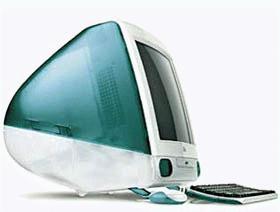 |
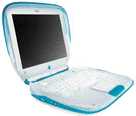 |
The newest computer here at Meerkat Meade, the iBard is a first-generation Apple iBook in Blueberry. It has a 266 MHz PowerPc G3 processor, 96 MB of memory, and a 4 GB hard drive. iBard is a major workhorse and allows us to take just about all of the resources at Meerkat Meade on the road. While at home, iBard connects to the Meerkat Meade LAN and the Internet via an onboard AirPort card, but on the road its built-in Ethernet connection allows it to link to other LANs, while the inboard modem connects us to the Internet. With a spiffy set of translucent blue AudioStorm flat-panel speakers, iBard is also an excellent traveling music center. With CDs converted to MP3 format, we can fit the contents of a dozen audio CDs on one data CD, nearly 12 hours of music on one disc. |
AirPort Base Station (2000)Meerkat Meade went wireless with the acquisition of Apple's AirPort Base Station. This wireless network hob, which uses the 802.11 standard, allows us to wander the house and grounds while wirelessly connected to the Meerkat Meade LAN and the Internet. Future computers can easily be added to the LAN with the addition of Apple AirPort cards, which currently run about $100 each. |
 |
 |
Don's Datapad (2000)Don carries a Palm III with a custom case from Cool Colors. Calendar, datebook, to-do list, address book, and much more, the unit is Don's indispensible companion, the perfect backstop for an aging memory. The datapad links to Orac by the standard docking cradle, and to the Meerimac via infrared beaming, which is the second-coolest thing in the entire world (AirPort being the coolest). |
Verizon DSL Service (2000)No, it's not a computer, but it sure enhances our computers. With DSL service, Meerkat Meade has an always-on, high-speed Internet connection over our regular telephone lines. And it doesn't interfere with voice, so we don't need a separate phone line for Internet access. Best of all, with the Xsense XRouter, our DSL connection is shared among all the computers on site. We can have -- and have had -- three people using the Internet simultaneously while another person talks on the phone. |
 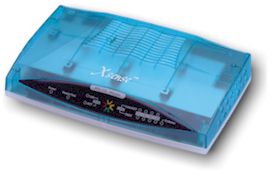 |
Don has seldom met an operating system that he didn't like, in one way or another.
Don likes Windows 95. It has some really nice features, along with an underlying elegance that is an improvement over its predecessors. Of course, there are also things about Windows 95 that drive Don crazy. (Like how come he can't assign a custom icon to each file when he wants?)
Don likes MacOS 8.6. It has some really nice features, along with an underlying elegance that it inherited from its predecessors. Of course, there are also things about MacOS 8.6 that drive Don crazy. (Like how come it doesn't have the "New xxx document" feature that Windows 95 does? Odd that Microsoft took the "desktop metaphor" a step further than Apple.)(And what's with all these nonstandard characters, ASCII was good enough for my father, and his father before him, and his father before him....)
Don loved AmigaDOS 2.0. It had some really nice features, along with an underlying power that gave the user unprecedented ability to make the machine do what he/she wanted. (How come neither Microsoft or Apple have implemented the CLI as elegantly as the Amiga? And scripting under AmigaDOS was a breeze compared to AppleScript and .BAT files.) However, there were also things about AmigaDOS that drove Don crazy. (Like the $#@&$#* CIA chips, one of which always burns out at the most inopportune moment.)
Don got to know the Commodore 64 OS pretty well, and had a lot of fun with it. (At one point, he had the machine reading his email to him.) Of course, there were things about Commodore 64 OS that drove him crazy. (Er...most of it, really, as I recall.)
Don loved the Tandy Model 100 and its simple, elegant OS. There was a protean machine. The Model 100 was always the last resort in transferring data from one computer to another. Apple II, C-64, Amiga, Mac, MS-DOS...that baby could talk to anything.
Don has even (shudder) played around with UNIX, and finds that there are things to like about it. (Makes sense, really, since AmigaDOS was based so much on UNIX.)
Just recently, when setting up the Meerimac's hard drive, Don moved accumulated email and postal correspondence files to their new home. This included files from as far back as 1985 . These files -- produced on machines as varied as the C-64, Tandy Model 100, Amiga, MS-DOS/Windows, and Macintosh -- have moved from machine to machine through the years, C-64 to Amiga to Windows to Macintosh. These files have been on 5.25-inch floppy drives under C-64 DOS and both 3.5-inch floppies and various hard drives under AmigaDOS, MacOS, and MS-DOS.
The files are perfectly readable. Some formatting may have been lost in translation, but Don found that he can easily recover text (and graphics) from any year back to 1985.
Of course, Don has been fanatical about migrating files from one system to the next. He uses software that can translate earlier file formats and compression schemes. Without periodic care, those 5.25-inch disks from 13 years ago would be unreadable and useless. (Well...almost. Don still has a trick or two up his sleeve.)
That's the point, though. With periodic care and judicious migration, digital data can survive for long periods. Just because the media wear out and the formats become obsolete, doesn't mean that the information has to be lost.